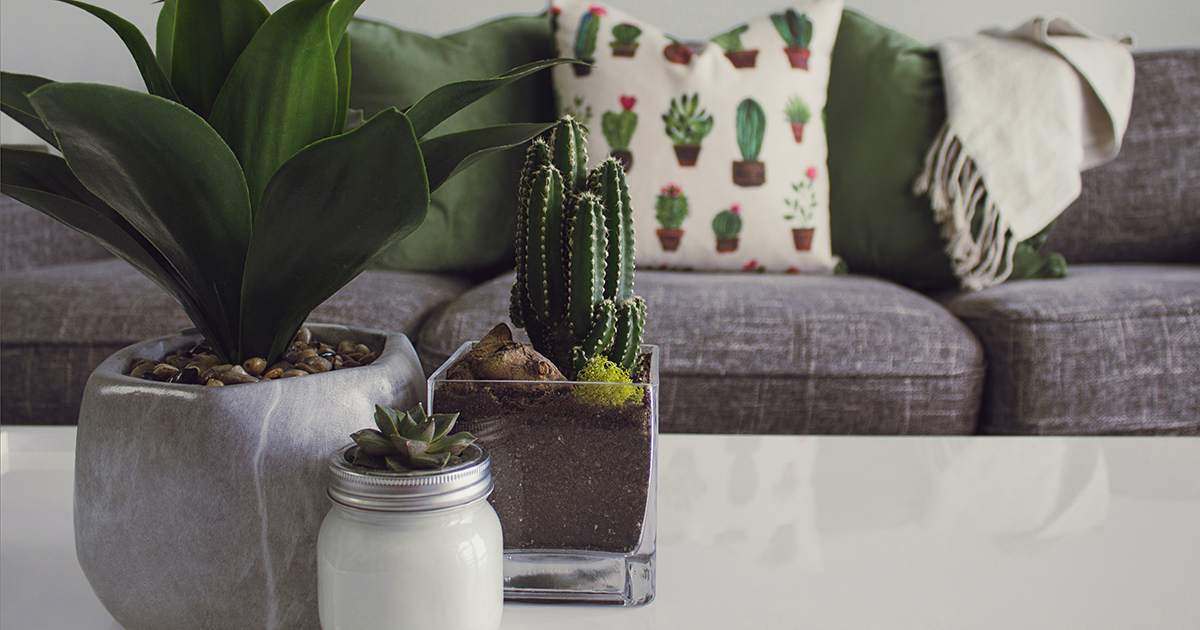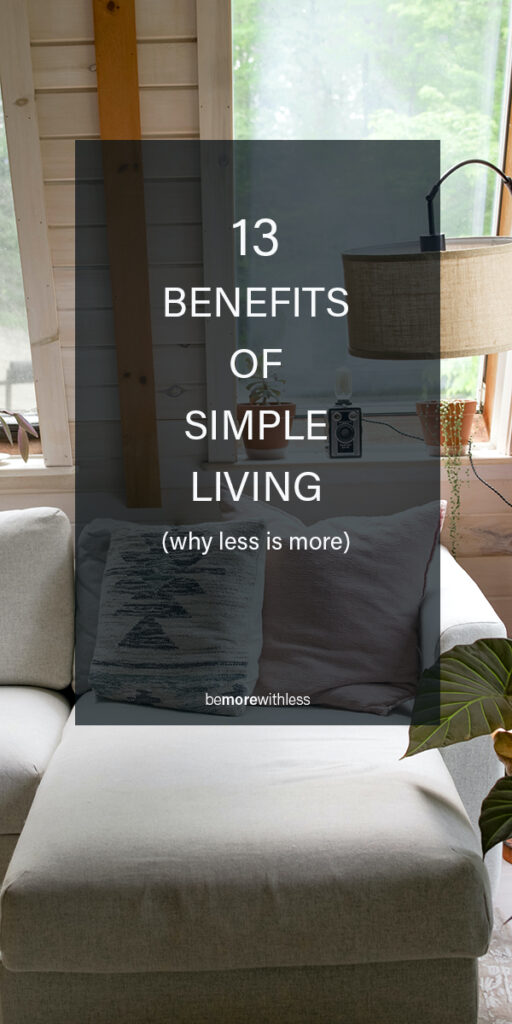My husband and I decided to simplify our lives to enjoy benefits like saving money, reducing stress, building strong relationships, and investing in experiences. For example, we recently took an overnight trip to a nearby city, stayed at a lovely hotel, explored a museum, ate lots of good food, and spent time with friends. It was a wonderful getaway that reaffirmed why we simplified our lives. We didn’t have the time or money to travel before we adopted simple living.
What Is Simple Living?
Like minimalism, simple living looks different for each person. Therefore, the definition of simple living will vary depending on individual needs and wants. I define simple living by answering the question, “How much is enough?”
Also, I come back to questions posed by Vicki Robin in Your Money or Your Life. She said:
“Defining ‘enough’ requires you ask yourself some crucial and pertinent questions:
- What makes you happy?
- What’s most important to you?
- What values will you never compromise?
- If you had $1 million right now, what would you do with your time?
- What’s one thing you could get rid of to make yourself happier? (a person doesn’t count)
- Will you ever have enough money to retire?
- If someone today erased all your debts, would you dig yourself into that hole again? How or how not?”
I love these questions because they help me examine my values and what “enough” means to me. For example, my husband and I lived in a tiny house for roughly five years. We outgrew our little house, though. We wanted a home that had more space for entertaining and cooking. Now we live in a two-bedroom apartment, and that is “enough” space for us.
13 Benefits of Simple Living
Below are 13 ways that simple living has benefited my life. Many of the benefits are inner-connected. For example, I couldn’t pay off my debt without evaluating my spending habits and relationship to consumerism. I hope you find my list of benefits helpful; especially as you craft a definition of simple living.
With that, let’s review my list . . .
1.) Understand and save money
Understanding and saving money is a crucial part of our simple living journey. Tracking our spending, income, and savings is educational and freeing. For example, it’s given us the ability to make career changes, pay for unexpected medical bills, and take trips.
2.) Say goodbye to consumerism
Evaluating my spending habits, and watching “The Story of Stuff,” helped me stop shopping for happiness at the mall. Needless shopping wasn’t good for my mental health, bank account, or the environment. Saying goodbye to consumerism helped me realize that I could find happiness, joy, and delight outside the mall.
3.) Stronger relationships
Most of the tips I shared in “How To Choose Happiness (even when it’s difficult)” involve social connection. Happiness research has shown that connection and strong relationships make people happy (not buying more stuff). That’s definitely true for me!
Dr. Laurie Santos – professor, scientist, and podcast host – said, “If you look at the positive psychology literature, one of the hugest effects on our own happiness is our social connection … Social relationships and strong social relationships are necessary for happiness. They’re not sufficient for happiness, but you can’t find happy people that don’t have them.”
4.) More time
As we simplified our lives, I noticed that I had more free time. I wasn’t spending my time at the mall, driving my car, or working so many hours. I also learned to say no. As a result, I had time to work on creative projects and hang out with loved ones.
Something that continues to help me: time audits. When I feel too busy, I track my time for a week. This is helpful because I’m able to reevaluate how I spend my time. From there, I prioritize and let go of the activities that no longer serve me.
5.) Improved work-life balance
Doing time audits helped me realize that I wanted to work less. Instead of working over 40 hours a week, I work roughly 25-30 hours a week. I don’t make as much money, but I have time to volunteer, work on creative projects, and take care of my family.
6.) Reduced stress
Paying off our debt, saving money, and commuting by bike reduced our stress levels.
Interestingly, The Commuting and Wellbeing Study found that “every extra minute of commute time reduces job satisfaction, reduces leisure time satisfaction, increases strain and reduces mental health.” Whereas, a shorter commute is likely to “increase job satisfaction” and “is associated with better self-reported health.”
Chronic stress is linked to negative health outcomes, so I’m grateful for my simple low-stress life.
7.) Better sleep
When I was stuck in the work-spend cycle, my sleep was disrupted frequently. At night, I worried about not being able to pay off my student loan debt. Today, I worry less and sleep better. And when I don’t sleep well, I examine what’s going on in my life.
8.) Less clutter means less cleaning
Letting go of clutter feels good, and it’s saved me time. I don’t have to clean as often, and spring cleaning is easier and fun. Also, owning less stuff is a way to save money. I spend less on insurance premiums, security costs, and maintenance costs.
9.) Reduced decision fatigue
Before I simplified my life, my closet was packed with clothes. It took me a long time to get ready in the morning because I didn’t know what to wear. Today, I have a minimalist wardrobe that I love. Plus, my tiny wardrobe has reduced decision fatigue. In essence, deciding what to wear in the morning isn’t an exhausting task.
10.) Increased gratitude
Over the past decade, I’ve shifted my focus from comparison to gratitude. Understanding that I have enough money, time, and love fills me with gratitude for all the good in my life. Tools that help me focus on gratitude include my journaling and photography practice.
11.) Savoring small pleasures
Savoring small pleasures — like going on a nature walk, reading a novel, or having coffee with a friend — is one of my favorite things to do. It’s been an unexpected and beautiful benefit of simplifying my life.
12.) Invest in experiences
Instead of buying stuff, we invest some of our money in experiences. I love taking trips and eating out. Not all experiences require spending money, though. Everyday adventures – like bike rides with friends and trips to the library – are a big part of my life. I can do these activities in my community. Plus, they are free and fun experiences!
13.) Build community
In the updated edition of Your Money or Your Life Vicki Robin wisely said, “Widen the circle of relatedness and you are in the third pillar of natural wealth: community. Community is a natural human currency. It is currency because it facilitates trade within communities that share and care outside the money economy.”
Over the years, I’ve become less and less attached to my belongings, more resilient, and focused on building community. Don’t get me wrong, having an apartment filled with select belongings is a privilege and comfort. However, my belongings won’t take care of me when I’m ill, struggling with my mental health, or experiencing grief. My community will take care of me, though.
Having the time and space to focus on my relationships and community is an amazing opportunity. For example, last summer I took a trip to visit friends. The trip deepened some of my friendships, and I reflect on it frequently. I’m looking forward to saving for our next trip with friends!
Resources to inspire simple living
Looking for resources that will help you simplify your life? Explore the list below:
Books
Below is a short list of my favorite books about simple living:
- Your Money or Your Life by Vicki Robin and Joe Dominguez
- Project 333 and Soulful Simplicity by Courtney Carver
- The Year of Less by Cait Flanders
- Rest is Resistance by Tricia Hersey
- Tiny Homes: Simple Shelter by Lloyd Kahn
Articles
Podcasts
Videos
- The Story of Stuff is an inspiring website that focuses on “honest conversation about our consumption-crazed culture.” You will find videos and other educational materials on the site.

